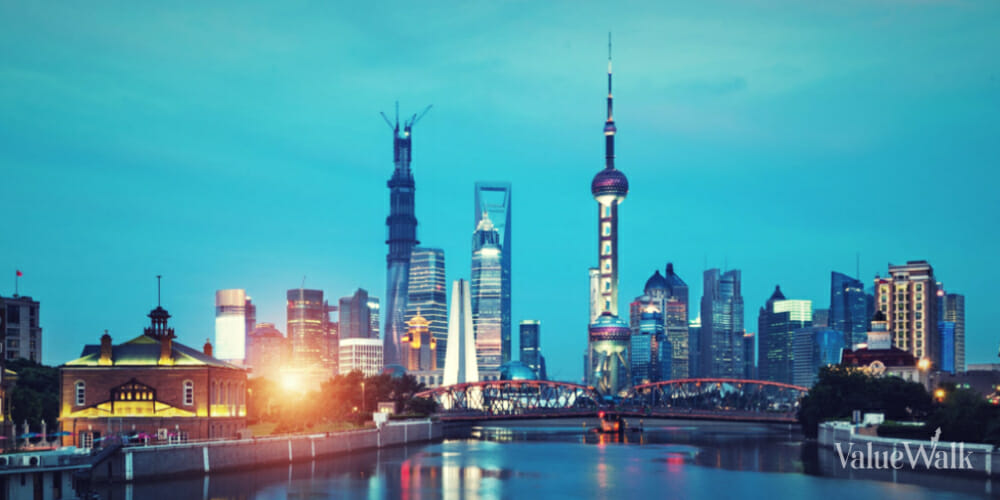For weekend reading, Gary Alexander, senior writer at Navellier & Associates, offers the following commentary:
August 8, or 8-8, is the luckiest day of the year in China, since 8 is pronounced “ba” in Mandarin – sounding much like the word for “fortune” or “prosperity,” making 8 an auspicious number.
Doubling or tripling your eights can double or triple your fortune. The Beijing Summer Olympics, for instance, opened at 8:08 pm on August 8, 2008, a five-fold “8” link, like the 5-loop Olympic logo. About 10,000 Chinese couples got married that day and hour to ensure the good fortune of their partnership.
When our investment group toured China in 1996, every room in our Wuhan hotel, on every floor, began with the number 8. Cell phone numbers without 8’s are cheap, but an investor reportedly bid $2,788 for the cellphone number 2008-0808, and a cellphone with six consecutive eights reportedly sold for $6,750.
Alas, China has had bad luck on August 8 in history (see below), but that doesn’t seem to stop them from honoring the digit 8. This week, I’d like to address another superstition – the fear of negative growth.
Since the end of the Cultural Revolution and death of Mao Zedong on September 9, 1976 (that’s 9-9, not 8-8), and then the emergence of the reform-minded Deng Xiaoping in December 1978, China has apparently delivered 45 straight years of positive GDP, and GDP growth of 14,500% in those 45 years!
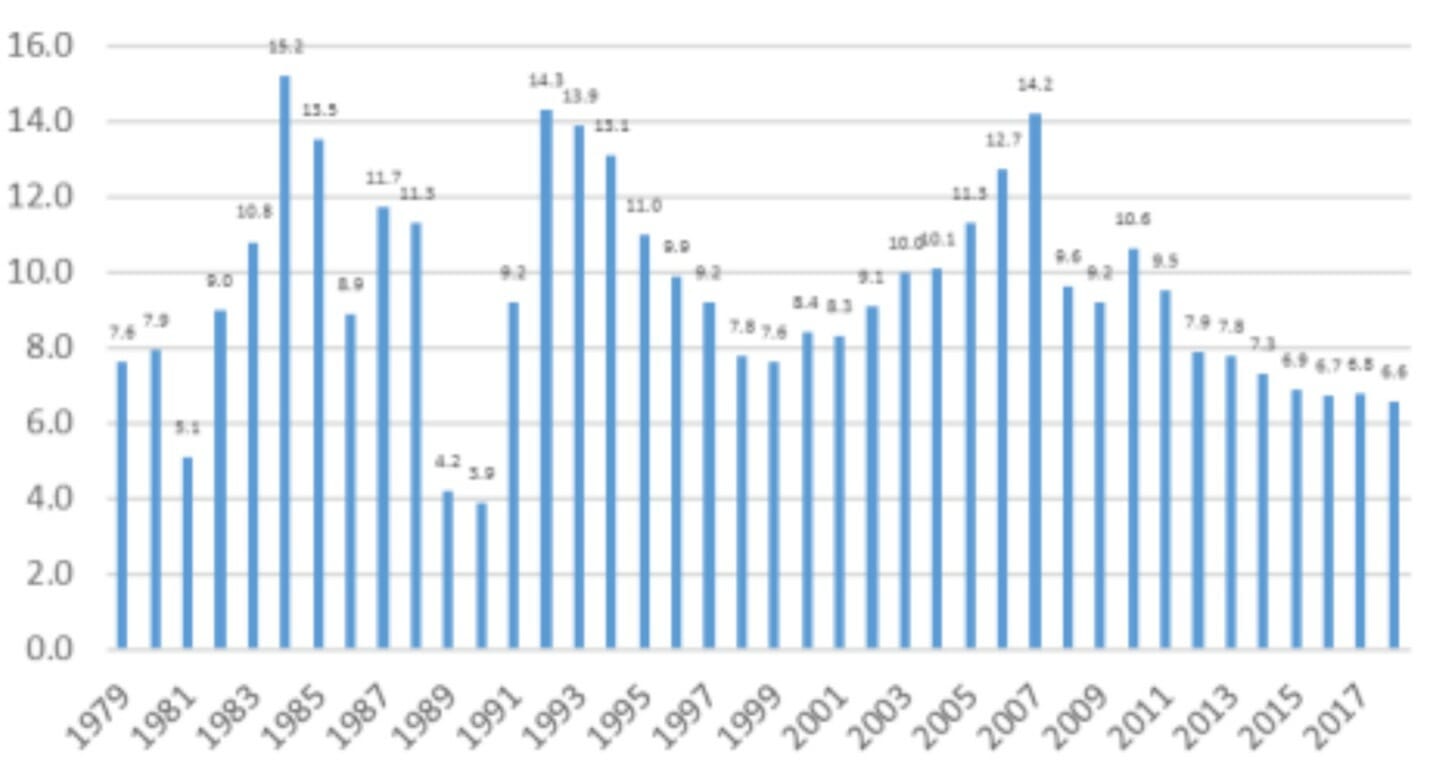
What’s more, those are HUGE growth numbers, for the most part, with 15 of 45 years in double-digit rates. Most of those numbers are probably accurate. Anyone who has seen China in the 1980s or 1990s vs. today can testify to the massive growth in wealth and infrastructure there. Anyone monitoring the trade dominance of China can verify the “Made in China” label monopoly. Trade statistics don’t lie.
China’s GDP has mushroomed from $150 billion in 1978 to $22 trillion in 2022, over 146-fold gains, or a compounded +11.5% per year for those 45 years, but the pace has slowed decidedly in the last decade:
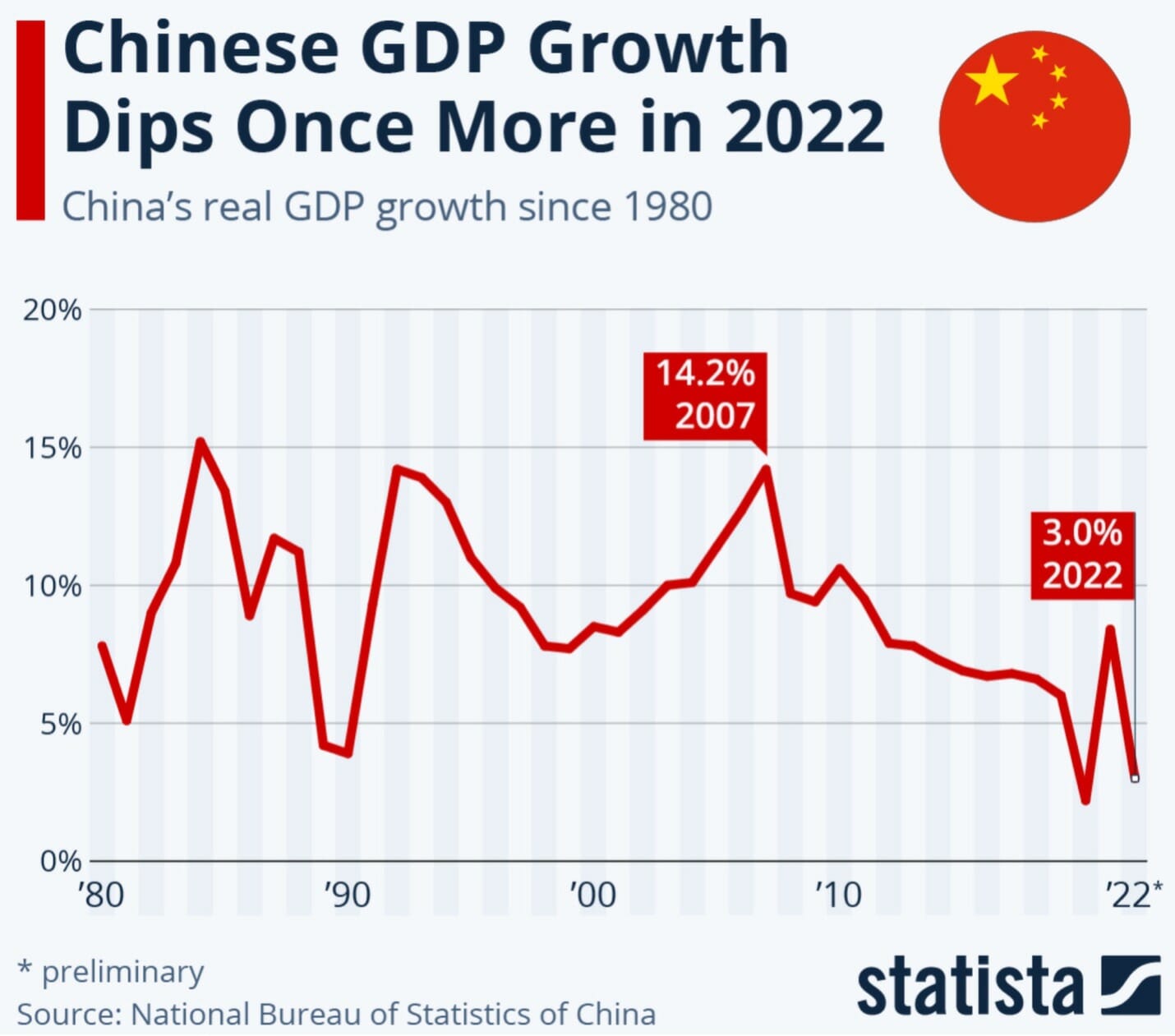
Before the COVID years of 2020-22, the closest China came to a recession was in the post-Tiananmen Square year of 1990 at +3.9%, and if there were ever some fudging of official statistics, that would be the time that China put its collectivist hands on the scales, but the overall record of growth is unprecedented.
Well, let me say it is ALMOST unprecedented. Such growth happened once before China, in Japan.
Japan Travelled This 45-Year Rocket Ride Before China
I wrote my first series of economic articles right out of college, over 55 years ago, after studying Japanese ship-building documents in late 1967. It became a series of three articles in a national magazine in early 1968 on the coming economic colossus, Japan.
From the depths of the first atomic bombs exploded there on August 6 and 9, 1945, Japan in 1967 was in the early stages of becoming the kind of global economic powerhouse in the 1980s that China is now. All the stories you read about China becoming #1 soon, replacing America, were the same stories we read about Japan replacing America “by the year 2000.”
Here’s a log-scale graph of the phenomenal growth of Japan, 1945-1990, bypassing once-Great Britain:
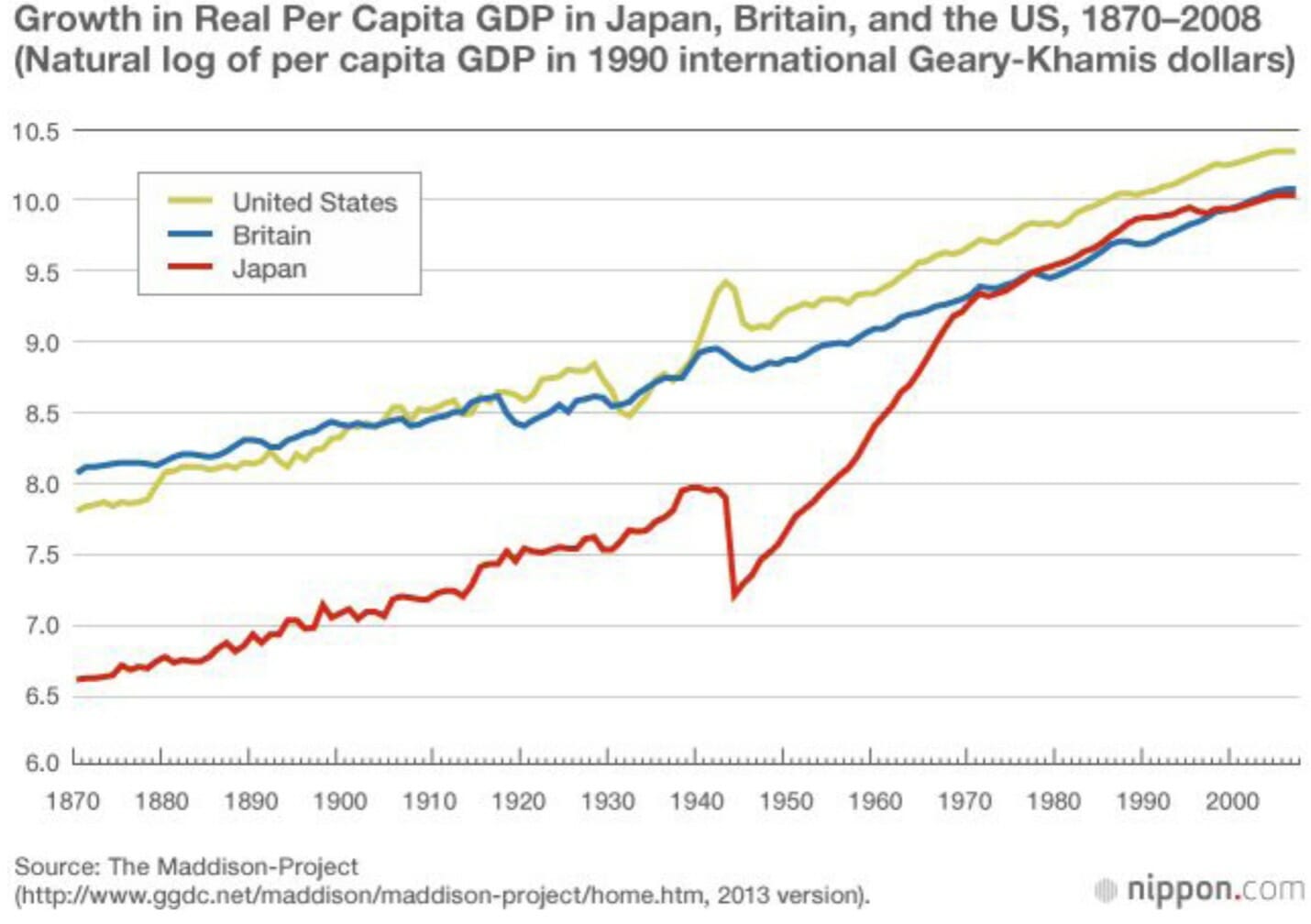
From the depths of America’s bombing raids in 1945 to the generosity of American businessmen helping rebuild that nation, Japan enjoyed 45 years of growth (1946-1990), similar to China’s last 45-year spurt.
Like China recently, Japan built its growth on exports, fueled by shipping. Over 55 years ago, I wrote:
“Japan’s sun has once again risen – and it is bigger and brighter than ever before! From the rubble and ruin of World War II, a New Japan has emerged. A mighty economic Supergiant…. For 12 consecutive years, Japan has led the world in [shipping] tons launched, amounting to 47 percent of all world production….
Only Japanese shipyards have the present capacity to construct tankers between 200,000 and 300,000 deadweight tons…. Once launched, these ships run themselves… The two largest ships in the world –both Japanese built–have a crew of 29 and 32, respectively!”
– “Japan – Industrial Supergiant” by Gary Alexander, Plain Truth magazine, January 1968
By 1989, the Japanese market peaked and so did their economy. Japan fell into a 34-year deflationary malaise. In 1989, some said, “One square mile of land in Tokyo is worth all the land in California,” but I and any rational soul said, “No, it’s not.”
Could the fate of Japan now be the future of China? Many fundamental factors point in that direction – including a 300% debt-to-GDP ratio, a huge demographic time bomb of fewer youthful workers coming up to service that debt and support the elderly, and a loss of trading partners due to a high-cost workforce and an arrogant dictator-for-life demanding total obedience.
The Wall Street Journal (on Monday, July 31, 2023, “Fear of Deflation Deepens in China as Growth Stalls”) shows how deflation has rapidly overtaken inflation in China and threatens its growth streak:
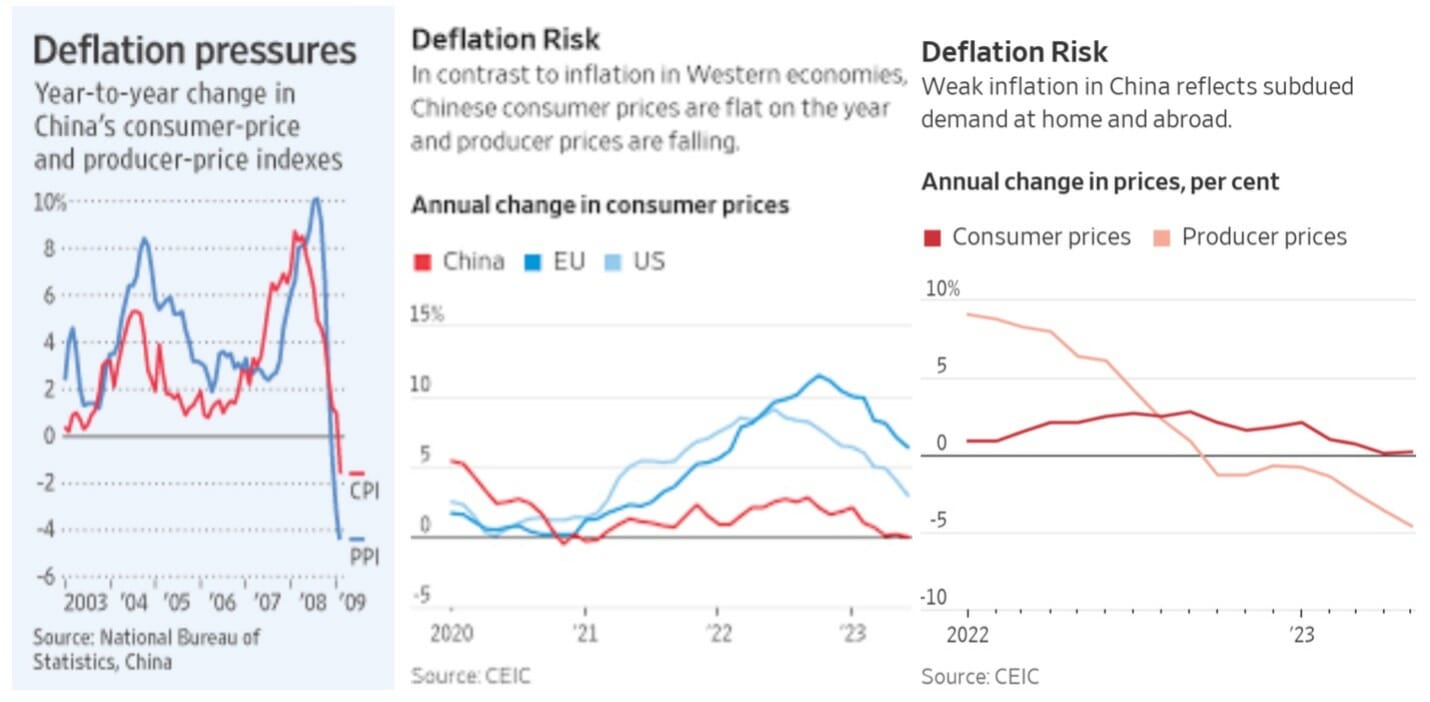
China’s GDP grew at just 0.8% in the second quarter (vs. the first quarter, seasonally adjusted), so we’ll see if 2023 breaks China’s 45-year winning streak. The next mega-trend in China may replicate Japan’s.
August 8 is Not so Fortunate in China’s Last 50 Years
Despite the 2008 Beijing Olympics, three recent disasters struck China on August 8, the worst in 1975:
The 1975 Banqiao Dam failure was the biggest of 62 dam failures in Henan province after Typhoon Nina struck in August. It was the third-deadliest flooding in history, putting over 10 million people in 30 cities and counties (in 3 million acres) under water, with a wide-ranging death count of from 26,000 to 240,000. Between 5.0 and 6.8 million houses collapsed, without warning, due to censorship at the time.
At 1:00am on August 8, 1975, flood waters at Banqiao crested at 387 feet above sea level, or one foot higher than the wave protection wall on the dam, and it failed. Over 700 million cubic meters (7.55 billion cubic feet) of water were released within six hours, while 18 billion cubic feet of water were released in 5.5 hours at an upriver Shimantan Dam, and 170 billion cubic feet were released in all 62 dam failures.
The resulting wave of water was 10 kilometers (6.2 miles) wide and 3-7 meters (10-23 feet) high, rushing into the plains below at 30 miles per hour, wiping out a region 34 miles long and nearly 10 miles wide, creating a temporary lake the size of Connecticut. Seven county seats were inundated. This and the Tangshan quake a year later (July 28, 1976), killing 242,679, were taken as a “Mandate from Heaven” for a change in rulership. Sure enough, China’s top two leaders, Mao Zedong and Zhao En Lai, died in 1976.
Two more “not-so-natural” disasters – the first one mostly man-made – also fell on August 8:
The 2010 Gansu mudslide was caused by decades of clear-cut logging, reducing the watershed’s ability to absorb heavy rainfall. The 2010 China floods ran from May to September, killing 3,189 with at least 1,056 missing and presumed dead. The worst slides began August 8, with 1,471 dying as of August 21.
On August 8, 2017, a devastating earthquake in Sichuan Province killed 25, injured 525, with 6 missing.
So… 8-8 isn’t such a great date in China, after all.
